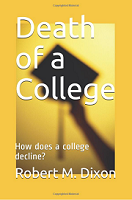Book Review: Death Of A College
By Robert M. Dixon, Ph.D.
 Approximately four years ago, I decided that the reasons commonly ascribed to the decline and closing of some institutions of higher education—particularly Historically Black Colleges and Universities (HBCUs)—deserved further exploration. My diverse experiences with boards of trustees, accrediting agencies, government officials, alumni organization leaders, university administrators and faculty members, journalists, and business leaders informed and inspired my decision to write a story about a once vibrant college that finds itself in decline.
Approximately four years ago, I decided that the reasons commonly ascribed to the decline and closing of some institutions of higher education—particularly Historically Black Colleges and Universities (HBCUs)—deserved further exploration. My diverse experiences with boards of trustees, accrediting agencies, government officials, alumni organization leaders, university administrators and faculty members, journalists, and business leaders informed and inspired my decision to write a story about a once vibrant college that finds itself in decline.
Death of a College is a story about Stonewood College, a fictitious institution located in Savannah, Georgia. In this story, I explore how the efforts of a college’s leadership team can be subverted by well-intentioned individuals whose shortcomings limit the college’s ability to change and survive. Death of a College presents the struggles of a once thriving historically black institution to adapt and survive declines in enrollment and donations, a budget deficit, and a twenty-million dollar debt to the U. S. Department of Education.
Throughout my career, I have encountered many of the challenges I write about in Death of a College. Although set in the 1980’s, the factors that drive the story forward are timeless and the problems explored in the book occur at a variety of colleges and universities throughout the country. Since the early 1980’s many HBCUs have encountered challenges, causing some to close and others to suffer dramatic declines. Often, the reasons for the decline of a college or university are connected to contentions about mismanagement. More broadly however, the challenges may include:
- Interference in management
- Insufficient resources
- Resistance to change
- Improper relationships
- Static systems
- Leadership enamored with the past
In Death of a College, I also explore dimensions of American culture, race, and leadership in the South during an era in which questions about the future of the HBCUs became more prevalent among some African Americans. Elements of racism are present and factor into actions taken by several characters. The story explores change and the difficulties that some persons have in adjusting to and understanding the need for change. Further, it explores the difficulty of maintaining the momentum of a vision forward when views of the past beco me so intoxicating. One of the goals of this books is to provoke thought and discussion about why some institutions close, and about the complexity of factors contributing to the decline of a university.
me so intoxicating. One of the goals of this books is to provoke thought and discussion about why some institutions close, and about the complexity of factors contributing to the decline of a university.
The story begins with a meeting of the board of trustees. The new president, Dr. Jason Hammer, has been invited to meet with the board in order to have a candid discussion about the problems facing the college, and the board’s expectations to overcome them. In that meeting, Dr. Hammer’s reasons for accepting the position are challenged, and future conflicts with the trustees are foreshadowed. Dr. Hammer quickly learns that the trustees are not well informed about the challenges they have addressed, and that they were not entirely honest with the new President during the search process.
The book is available on Amazon books. I hope you will find your experience with the book as fulfilling as I did in writing it.
HIRE AN INTERIM
Searching for an Interim?
Please contact us for more information.

